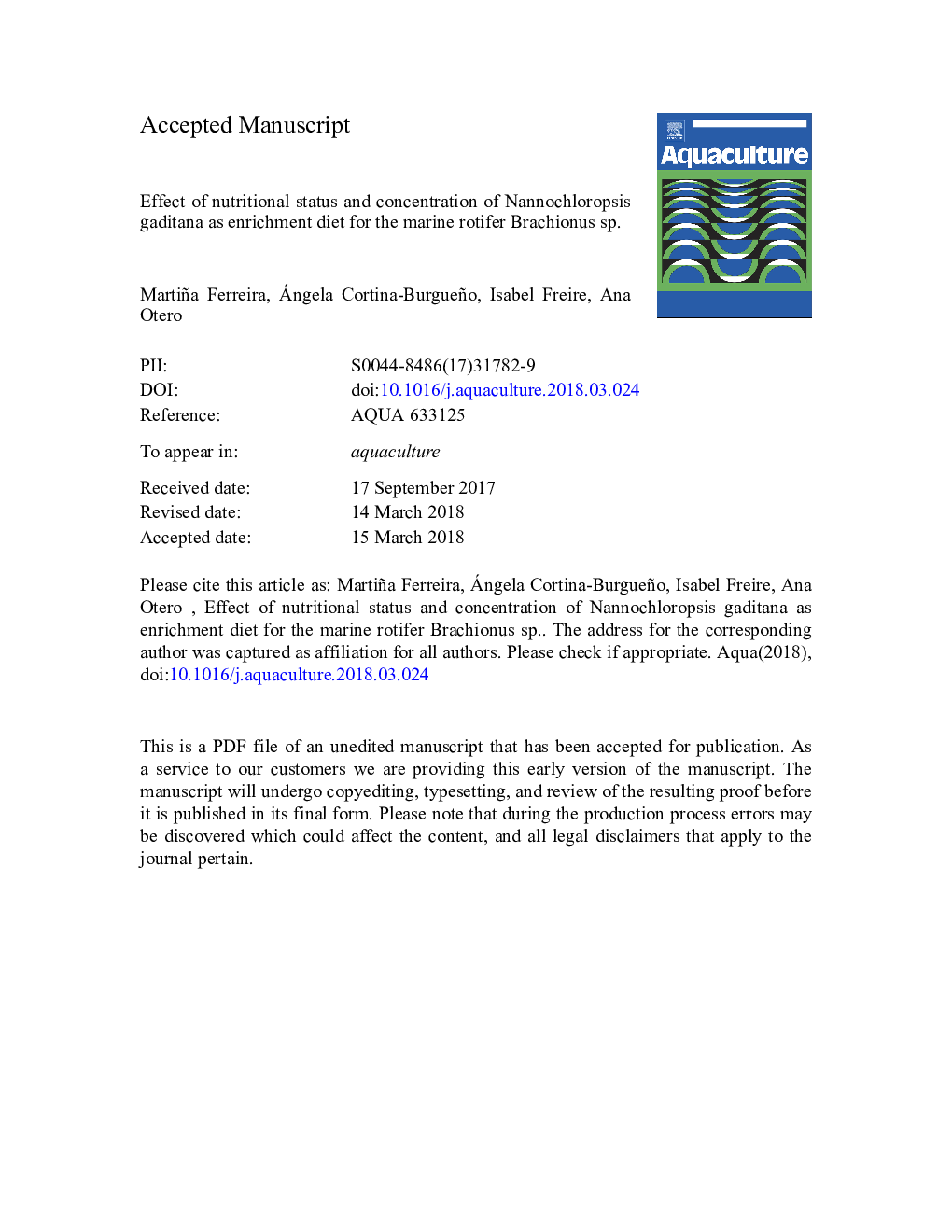| کد مقاله | کد نشریه | سال انتشار | مقاله انگلیسی | نسخه تمام متن |
|---|---|---|---|---|
| 8493278 | 1552797 | 2018 | 29 صفحه PDF | دانلود رایگان |
عنوان انگلیسی مقاله ISI
Effect of nutritional status and concentration of Nannochloropsis gaditana as enrichment diet for the marine rotifer Brachionus sp
دانلود مقاله + سفارش ترجمه
دانلود مقاله ISI انگلیسی
رایگان برای ایرانیان
کلمات کلیدی
موضوعات مرتبط
علوم زیستی و بیوفناوری
علوم کشاورزی و بیولوژیک
علوم آبزیان
پیش نمایش صفحه اول مقاله

چکیده انگلیسی
The development of strategies to improve the quality and to optimize the costs of rotifer production for fish larval feeding, particularly those related to microalgal supply, are highly desirable. In the present work, three different rations (80,000, 130,000 or 200,000 cells rotiferâ1) of Nannochloropsis gaditana were assessed as enrichment diets for the marine rotifer Brachionus sp. The microalga was cultured in semi-continuous regime with two different daily renewal rates, 10% and 40%, which provided nutrient-depleted or nutrient-sufficient conditions respectively and resulted in strong differences in biochemical composition. Protein and arachidonic acid (ARA) content were twice higher and eicosapentaenoic acid (EPA) was three times higher in N. gaditana from nutrient-sufficient cultures. After 24-h enrichment, rotifers fed N. gaditana cultured in nutrient-sufficient conditions showed higher dry weight, as well as higher contents of protein, lipids and carbohydrates. Total polyunsaturated fatty acids (PUFAs) and ARA contents increased >50%, whereas EPA content doubled in rotifers fed N. gaditana from nutrient-sufficient conditions. As for feed ration, the increase from 80,000 to 130,000 cells individualâ1 enhanced the accumulation of protein, lipids, carbohydrates, total PUFAs, ARA and EPA, but a further increase to 200,000 cells individualâ1 only enhanced the accumulation of lipid content. Our results show that the nutritional quality of microalgae, rather than concentration, is the most important factor influencing biomass productivity and biochemical composition of rotifer cultures. Since microalgal biomass is in general a limited resource for aquaculture, the improvement of its nutritional value through the optimization of culture conditions should be considered as an adequate and cost-efficient strategy to produce high-quality live feed.
ناشر
Database: Elsevier - ScienceDirect (ساینس دایرکت)
Journal: Aquaculture - Volume 491, 1 April 2018, Pages 351-357
Journal: Aquaculture - Volume 491, 1 April 2018, Pages 351-357
نویسندگان
Martiña Ferreira, Ángela Cortina-Burgueño, Isabel Freire, Ana Otero,